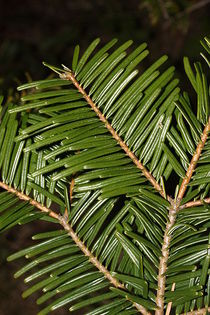
Picture of the has been licensed under a GFDL
Original source: Own work
Author: Walter Siegmund (talk)
Permission: GNU Free Documentation License
Original source: Own work
Author: Walter Siegmund (talk)
Permission: GNU Free Documentation License

Grand fir
The leaves are needle-like, flattened, and grow in a single flat plane , 3–6 cm long and 2 mm wide by 0.5 mm thick, glossy dark green above, and with two green-white bands of stomata below, and slightly notched at the tip. The leaf arrangement is spiral on the shoot, but with each leaf variably twisted at the base so they all lie in two more-or-less flat ranks on either side of the shoot. The cones are 6–12 cm long and 3.5–4.5 cm broad, with about 100-150 scales; the scale bracts are short, and hidden in the closed cone. The winged seeds are released when the cones disintegrate at maturity about 6 months after pollination.Abies grandis (Grand Fir, Giant Fir, Lowland White Fir, Great Silver Fir, Western White Fir, Vancouver Fir, or Oregon Fir) is a fir native to the Pacific Northwest of North America, occurring at altitudes of sea level to 1,800 m. It is a large evergreen coniferous tree growing to 40–70 m (exceptionally 80 m) tall and with a trunk diameter of up to 2 m. More
* Media related to Abies grandis at Wikimedia Commons * Gymnosperm Database: Abies grandis * USDA Plants Profile: Abies grandis This entry is from Wikipedia, the leading user-contributed encyclopedia. More
Abies grandis is native to North America. Range may be expanded by planting. See states reporting grand fir (opens a new window). More
